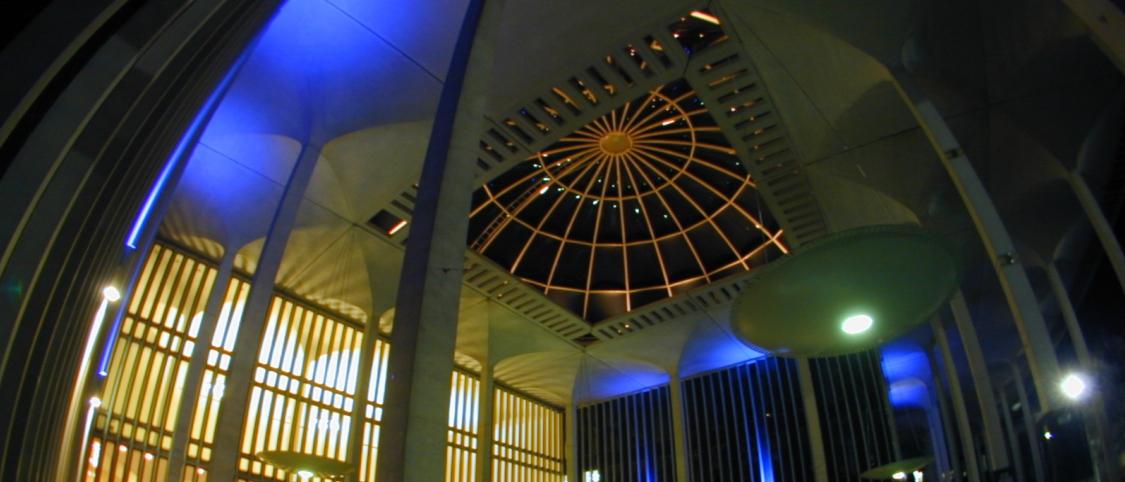
2024-25 Season
The Department of Music and Theatre Presents:


2024-25 Season
The Department of Music and Theatre Presents:
Kevin Champagne, Conductor

Entry of The Gladiators - Fucik
Fiesta Del Pacifico - Nixon
Tribute to The Count - Nestico
Pilatus: Mountain Of Dragons - Reineke



Christopher David Neubert, Conductor
Tchaikovsky Symphony No. 6



Wednesday, March 12 at 7:30 pm Main Theatre
Department of Music and Theatre
University at Albany
presents:
Kevin Champagne, conductor and
Christopher David Neubert, conductor
Wednesday, March 12, 2025 at 7:30pm
Main Theatre
UAlbany Performing Arts Center
Program
UAlbany Concert Band
Entry of The Gladiators………………………………………Fucik
Fiesta Del Pacifico…………………………………………...Nixon
Tribute to the Count.……………………………...............Nestico
Pilatus: Mountain Of Dragons…………………………...Reineke
Symphony Orchestra
Pyotr Ilyich Tchaikovsky 1840-1893
Symphony No. 6, Op. 74……………………………...Pathetique
III Allegro molto vivace
IV Finale – Adagio lamentoso
Program Notes
Entry Of The Gladiators – Julius Fucik (1872-1916)
Arr. By J.S.
Seredy
Despite Fucik’s many works, the “Czech March King” is best known for Entry Of The Gladiators. The march was originally titled Grand March Chromatique, but Fucik’s fascination with ancient Rome and the spectacle of gladiatorial combat made him later change the name. It became part of the genre of American circus music of the day (and still) often referred to as a “screamer.” Fucik also composed numerous overtures, waltzes, and dozens of marches.
Fiesta Del Pacifico was one of several festivals held annually in several communities in California which celebrate the Old Spanish Days of the state. This particular festival was held in San Diego for several years in the 1950’s. It started as a 33 day celebration, but became much smaller before fizzling out. Roger Nixon was a music Professor at San Francisco State College. He composed many pieces for band, and a few for orchestra, piano, small ensembles, and an opera.
Count Basie’s contribution to the history of jazz and blues has been monumental. Since the early 1930’s, William C. Basie has been one of the legends of jazz. In 1935 he formed the Count Basie Orchestra in which he developed the “split tenor” writing style, made emphasis of the rhythm section, made riff jazz popular, and created a smooth style of swing playing, often highlighting his minimalist piano playing style. This medley features April In Paris, Li’l Darlin’, Shiny Stockings, and One O’Clock Jump. The arranger, Sammy Nestico has written, arranged, conducted, and produced music with Basie, Streisand, Quincy Jones, Phil Collins, Buble, Sinatra, and many others. He also played trombone in bands with Tommy Dorsey, Gene Krupa, and Woody Herman.
Pilatus was commissioned by the Jugend-Blasochester of the city of Lucerne, Switzerland. This programmatic tone poem (think “soundtrack”) opens as Mount Pilatus slumbers at night, shrouded in darkness and mystery among the clouds high above Lucerne. As dawn breaks, a band of courageous adventurers climbs Pilatus in search of dragons to slay. After an arduous journey filled with breathtaking views and terrestrial beauty, the adventurers finally stumble across a dragon lair.
They awaken the dragon which now must battle the intruders of his domain. All but one are mortally wounded, leaving the pitiful human to beg for mercy and forgiveness from the dragon. Demonstrating great compassion, the dragon produces a magical stone, called draconite, from his own wounds in order to heal and save the intruders. In doing so, the dragon has placed compassion and tolerance in the hearts and minds of man, leading them to a happy and peaceful co-existence with the dragons of Pilatus.
The Symphony No. 6 in B minor, Op. 74, also known as the Pathétique Symphony, is Pyotr Ilyich Tchaikovsky's final completed symphony, written between February and the end of August 1893. The composer entitled the work "The Passionate Symphony", employing a Russian word,
(Pateticheskaya), meaning "passionate" or "emotional", which was then translated into French as pathétique, meaning "solemn" or "emotive".
The composer led the first performance in Saint Petersburg on 28 October of that year, nine days before his death. It was the last of Tchaikovsky's compositions premiered in his lifetime.
The Russian title of the symphony, Патетическая (Pateticheskaya), means "passionate" or "emotional", not "arousing pity," but it is a word reflective of a touch of concurrent suffering. Tchaikovsky considered calling it
(Programmnaya or "Program Symphony") but realized that would encourage curiosity about the program, which he did not want to reveal.
His brother Modest claims to have suggested the Патетическая title, which was used in early editions of the symphony; there are conflicting accounts about whether Tchaikovsky liked the title, but in any event his publisher chose to keep it and the title remained. Its French translation
Pathétique is generally used in French, Spanish, English, German and other languages.
In February 1893, Tchaikovsky mentions an entirely new symphonic work in a letter to his nephew "Bob" Davydov:
Now, on my journey, the idea of a new symphony came to me, this time one with a programme, but a programme that will be a riddle to everyone. Let them try and solve it ... The programme of this symphony is completely saturated with myself and quite often during my journey I cried profusely. Having returned, I have settled down to write the sketches and the work is going so intesely, so fast, that the first movement was ready in less than four days, and the others have taken shape in my head. Half of the third movement is also done. There will still be much that is new in the form of this work and the finale is not to be a loud allegro but the slowest adagio.
I am now wholly occupied with the new work ... and it is hard for me to tear myself away from it.
The symphony was written in a small house in Klin and completed by August 1893. However, the composer began to feel apprehension over his symphony, when, at rehearsals, the orchestra players did not exhibit any great admiration for the new work. Nevertheless, the premiere was met with great appreciation. Tchaikovsky's brother Modest wrote, "There was applause and the composer was recalled, but with more enthusiasm than on previous occasions. There was not the mighty, overpowering impression made by the work when it was conducted by Eduard Nápravník, on November 18, 1893, and later, wherever it was played."
The Symphony is written in four movements.
Today’s performance includes movements three and four:
III. Allegro molto vivace
The third movement starts with a scherzo, a playful, march-like weaving in a sonatina form. The strings establish a fast, light compound meter which later lies underneath more brusque wind fanfares. This leads to the jubilant E major secondary theme in full, first given quietly by unison clarinets with a continued string accompaniment. Between the exposition and the recapitulation, there is no development section – only 2 bars of fragmentary retransition. The opening theme reappears emboldened, and after flourishes of scales traded between the strings and woodwind, the secondary theme returns triumphantly in G major.

Back in B minor, although opened with striking half-diminished harmony, the fourth movement takes a slow six-part sonata rondo form (A-B-A-C-A-B). The opening A theme in the first and second violins appears frequently through the movement, varying in intensity. The theme is a "composite melody": at first, neither the first nor second violins play in full the upper line that is heard.

A calmer B theme in D major builds up to a full orchestral palette, with driving brass and descending scales pushing to a
Neapolitan C major caesura. The B theme is transformed in a dramatic return to B minor before the A theme returns. Similarly to the first movement, there is a turbulent climax with prominent trombones in the development section (the C theme). This is followed by the most agitated restatement of the A theme (the start of the recapitulation), on an F♯ bass pedal. The music fades into a single, unique strike of a tam-tam; this quietly introduces a funereal chorale in the low brass which rounds off the dominant harmony. The return of the B section, originally a break in the clouds, is richly mournful, coinciding with the final resolution to B minor. The waves of descending muted string motifs carry on down into the lower strings and bassoons, finally dying away in total tragedy.
Among Tchaikovsky's symphonies, this is the only one to end in a minor key. His first, second, fourth and fifth symphonies, plus the Manfred Symphony, are all minor-key symphonies that end in the tonic major, while the home key of his third symphony is D major (even though it begins in D minor) and that of his unfinished Symphony in E♭ (unofficially "No. 7") is E♭ major.
It is also unusual for a slow movement to come at the end of a symphony. The despondent effect of the structural upheaval here has been the subject of much critical analysis. Had Tchaikovsky followed the standard four-movement structure, the movements would have been ordered like this:
I. Adagio – Allegro non troppo
II. Adagio lamentoso (actually IV)
III. Allegro con grazia (actually II)
IV. Finale: Allegro molto vivace (actually III)
UAlbany
Kevin Champagne, Conductor
Piccolo
Brianna Boyce
Flute
Abby Davis
Andrew Meng
Magdalena Ramos
Oboe and English
Horn
Ian Cohen
Clarinet
Grace Augenstern
Kelsey Classen
Avery Jackson
Stephanie Nielson
Stephanie Oshiotse
Elise Raponkus
Dan Truax
Bass Clarinet
Jake Avella
Ryan O’Connell
Alto Saxophone
Brian Feder
Randy Knarr
Ashleigh Koenig
Jack Piranio
Paul Wechsler
Tenor Sax
James Caruso
Jordynne Marshall
Xavier Rosario
Trumpet
Cirava Hammond
Dasha Hegeman
Keziah Job
Carly Johnson
Kal Tellefsen
Carlton Truax
Daniel Zamroz
French Horn
Emma Clements
Hailey Preston
Trombone
Rachel Grudus
William Lemus Silva
Rich Massa
Andrew Scaptura
Baritone/Euphonium
Andrew Brunetti
Tsvi Gold
Sylvar NazarioGoodwin
Catherine Semaska
Jay Smith Tuba
Andre Speller
Jordan Teo
Percussion
Angie Calero
Aaron Guzman
Milan Jevremov
Samantha Olszewski
Klarke Parnell
Ciara Reilly
Renee Scott
Jonathan Wolter
Band Manager
Keziah Job
Christopher David Neubert, Conductor
Violins
Bryan Fonder
Concertmaster
Nicole Maher
Leah Magee
Amelia Desmarais
Logan Stone
Allison Ellis
Adrian Ramos
Kyde Power
Amanda Sue
Principal
Hope Savercool
Sophia Minuto
Madelyn Knopfke
Katy Christman
Olivia Arsenicos
Lin Song
Cristina Schiaffo
Paige Dougher
Liz Gingrich
Isabelle Savage
Abigail Johnson
Marcella Reiter
Melissa Yusaitis
Ajani Johnson
Luke Santarpia
Violas
Dara Ribis
Principal
Kayla Wardlaw
Melissa Rosas
Samantha Dalton
Catherine Rafferty
Sam McElroy
Thaddeus Conner
Brenda Padilla De
Jesus
Riley Bowman
Jaime Kendrick
Cellos
Alisa Bielert
Principal
Connor Gordon
Michael Krachenfels
Dan LaPlante
Claire Choi
Renee La Londe
Abigail Tsuji
Seth Chaiken
Ryosuke Takahashi
Double Basses
Erik Laurin
Principal
Joey Aragones
Connor Hoolan
Ayva Dell
Chamille Malcolm
Piccolo
Maria Mucaria
Flutes
Melynda Matheke
Isabella Bulnes
Brianna Boyce
Magdalena Ramos
Oboe
Tyler Leicht
Ian Cohen
Clarinets
James Affatigato
Emily Lucy Ryan O’Connell
Bassoons
Laura Canham-Lunde
Jennifer Fullam
French Horns
Shannon Broda
Jonah Hauf
Erica DeNicola
Sarah Howard Trumpets
Peter Bellino
Ethan Chen
Sean Cummins
Trombones
Caleb Clapper
Jessica Watson
Matthew Scheidt
Tuba
Jacob Reiter
Tympani
Jonathan Wolter
Percussion
Yeajee Chon
Andre Speller
Orchestra Librarian and Management
Hope Savercool
Assistant Jonathan Wolter


Music Program (518) 442-4187
www.albany.edu/musicandtheatre
PerformingArts Center (518) 442-3995
www.albany.edu/pac


Theatre Program (518) 442-4200
www.albany.edu/musicandtheatre
Latecomers will be seated at the discretion of the management and its staff.
The use of photographic or recording devices of any kind during this performance is strictly prohibited.
There is no food or drink allowed in the theatres, nor is smoking allowed in UAlbany buildings.
. To avoid disrupting the performance, kindly disable any noise making electronic devices you may have with you.
Please take time to note the location of the fire exits nearest to you. In the event of an emergency, an announcement will be made from the stage. Please proceed to the nearest exit in an orderly fashion.

The UAlbany Performing Arts Center’s six theatres, three lounges and other spaces are available for rental.
The UAlbany Performing Arts Center’s six theatres, three lounges and other spaces are available for rental.





